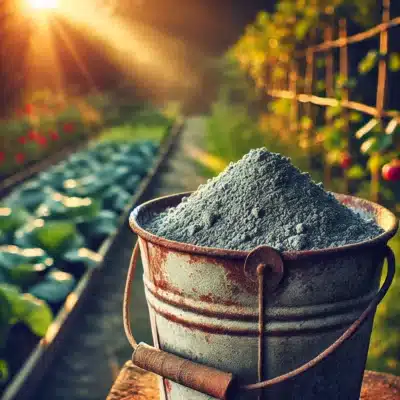
For anyone who relies on wood-burning stoves or fireplaces, the accumulation of ashes can sometimes feel like an unwelcome chore. Sweeping out that soft gray powder might seem tedious, but off-the-gridders, homesteaders, and gardeners in the know have discovered a hidden treasure buried in those dusty heaps.
Wood ash, it turns out, can be a powerful and natural way to enrich your soil and help boost plant growth, making it a valuable, low-cost addition to your gardening routine. By understanding the composition and benefits of wood ash and using it wisely, you can turn a routine cleanup task into an off-grid asset that saves money and improves your spring garden yields.
What’s Really in Wood Ash?
Before sprinkling it onto your garden beds, it’s essential to understand what makes wood ash so beneficial. Wood ash primarily comprises the minerals that remain after wood is burned. These minerals include calcium, potassium, magnesium, and trace amounts of other micronutrients such as iron and zinc.
Calcium helps maintain proper soil pH, buffer acidity, and improve soil structure so plants’ roots can better access water and nutrients. Potassium (the “K” in the classic N-P-K formula for fertilizers) is a crucial nutrient for overall plant health, aiding in root development and helping plants resist disease and withstand stress. Magnesium contributes to chlorophyll production, essential for photosynthesis and vigorous leaf growth.
Notably, wood ash contains no nitrogen, which doesn’t necessarily disadvantage your plants. Instead, consider wood ash a complement to other natural amendments you might already use, like compost or well-rotted manure. Nitrogen can be sourced from those composted materials, while the ash provides the minerals and pH-balancing properties that foster healthy microbial activity and root growth in the soil. In short, wood ash can round out the soil fertility picture, improving the effectiveness of the nutrients you’re already adding.
Gently Balances Soil Acidity
One of the primary benefits of wood ash is its ability to neutralize overly acidic soil. Many garden soils, especially those in rainy or forested regions, tend toward acidity. Acidic soil can lock up essential nutrients, making them unavailable to plants and reducing growth rates.
Applying wood ash—an alkaline substance—can gently raise the soil’s pH level, creating a more hospitable environment for crops. The result is more robust harvests, hardier plants, and less money spent on commercial lime or pH buffers.

From winter’s embers to a garden’s promise—wood ash waiting to nourish new life.
How to Apply Wood Ash to Your Garden
Knowing how, when, and where to apply wood ash is crucial for maximum benefit and avoiding potential pitfalls. Generally, a light sprinkling of wood ash can be used in garden beds in the fall or early spring. Adding ash to the garden when the soil is not actively supporting delicate seedlings can help the minerals incorporate more evenly and work their magic before planting time arrives.
As a rule of thumb, use about a half cup of ash per square foot of garden area, mixing it well into the top few inches of soil. For perennials or established shrubs, gently scratch a smaller amount of ash into the soil around their base. If you are uncertain about your soil’s pH, consider testing it before and after adding ash, as you don’t want to overshoot and make your soil too alkaline.
Pairing Wood Ash with Other Amendments
Treating wood ash as a valuable soil supplement rather than a standalone fertilizer truly shines. Combine it with composted kitchen scraps, green manure, or leaf mold to create a well-rounded nutrient profile. The ash will help free up the nutrients in compost, and together, they’ll make a rich, crumbly soil that supports an abundant garden. Over time, you’ll notice increased earthworm activity, healthier root systems, and a reduction in the need for store-bought fertilizers.
Storing Ash Properly
Off-the-grid households often generate ash continuously throughout the heating season. It’s wise to have a dedicated metal container with a tight-fitting lid for ash collection, stored in a dry, safe location. Keeping your ash dry is especially important, as clumpy, wet ash is more challenging to spread evenly and can cake up in your soil. By spring, you’ll have a supply of fluffy, mineral-rich ash ready to be worked into your soil, giving your garden an early advantage when the growing season begins.
A Great Step Toward Self-Sufficiency
Relying on your own home-heating solutions to produce a soil amendment reduces waste. It promotes a spirit of independence and resourcefulness. When you recycle your wood ash into your garden, you move closer to authentic off-grid living. You’re cutting down on the need for store-bought fertilizers, supporting robust plant growth, and making the most of every available resource.
You’ll gain confidence and knowledge with each annual cycle of burning wood for warmth, collecting ash, and applying it to your garden. Soon, you’ll see that what once seemed like a messy byproduct of heating your home can become a reliable, natural solution for nourishing the land.
In embracing wood ash for soil health, you transform a humble pile of gray dust into a powerful off-grid ally—one that will help you produce stronger crops, spend less money, and savor the fruits of your labor when harvest time comes.


























